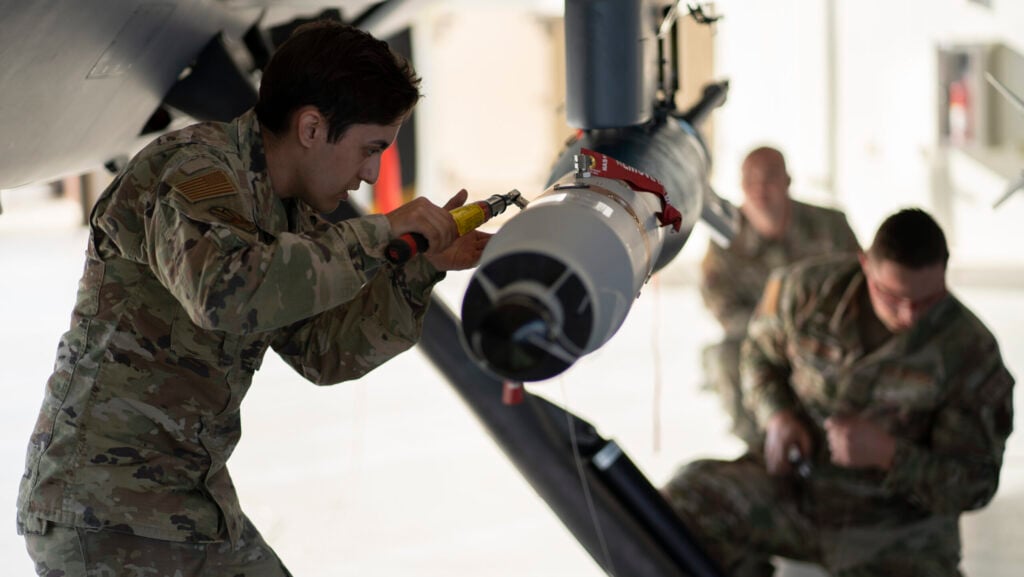US Air Force Senior Airman Gabriel Poersch, 432nd Aircraft Maintenance Squadron crew member, finishes loading munitions onto an MQ-9 Reaper during the third quarterly load crew competition between Tiger and Reaper AMUs at Creech Air Force Base, Nevada, Oct. 20, 2023. (US Air Force photo by Tech. Sgt. Emerson Nuñez)
As the global strategic environment worsens, the race to innovate in the domain of energetic materials —crucial components of modern weaponry — is only going to become more intense.
Military organizations in advanced countries have struggled to keep pace with an emerging transition from legacy explosives like HMX and RDX to next-generation capabilities, a transition made necessary by the rough parity they have achieved in conventional military terms. In recent decades, the United States has pursued a conservative approach, focusing on incremental improvements to tried-and-true materials.
However, our strategic competitors, notably China, have underwritten far-reaching, fundamental research in advanced energetic materials that could one day redefine the parameters of firepower and munition effectiveness.
This pivot towards a new generation of materials is not just about achieving higher energy outputs or more stable formulations; it signifies a deeper, more strategic game of military one-upmanship wherein success lies not just in scientific breakthroughs but in effectively transitioning these innovations into operational weapons systems.
Beginning with the release of the National Energetics Plan mandated by the 2020 NDAA, the Energetics Technology Center (ETC) has been closely tracking global research and development of high-performance energetic materials. Of particular interest is the synthesis of explosives and propellants exceeding the performance of the most powerful explosives currently produced in meaningful quantities.
Over the past two decades, scientists in China and Russia have aggressively pursued basic research that stands to yield new classes of munitions in decades to come. This includes investments in compounds that exceed the performance of CL-20, currently the most powerful non-nuclear explosive produced in any meaningful quantity in the US. Developed in 1987 at the US Navy’s China Lake research and engineering facility, CL-20 is used only in limited applications and has not yet been transitioned into US weapons systems at large-scale. The shift in munitions priorities after the dissolution of the Soviet Union, which redirected focus from greater lethality to enhancing safety and reducing cost and risk, along with the lack of specific funding or requirements to mature CL-20 for incorporation into systems, has meant that US forces continue to rely on energetic materials developed during the Second World War.
RELATED: Ukraine war shows America could be outgunned without investing in energetics
In the meantime, there is evidence that China has invested heavily for more than a decade to produce CL-20 at industrial scale, presumably to realize significant advantages in the performance of its weapons systems and solid rocket boosters. Even more concerning, US adversaries are laying the groundwork to surpass the performance of CL-20, with the clear intent of enhancing munitions efficacy and dramatically altering the strategic landscape.
For instance, emerging classes of Energetic Metal Organic Frameworks (EMOFs) and other novel energetic formulations are being investigated, which promise higher energy outputs, greater stability, and improved environmental profiles. Some of the new materials show higher detonation velocities than CL-20, which relates to how fast an explosive reaction travels through a material. Higher velocities often mean more powerful explosions, which are critical for applications requiring maximum impact from minimal material. Still others exhibit “specific impulses” higher than those of CL-20, which — in the context of explosives and rocket propulsion — refers to a measure of how efficiently a propellant is used to produce thrust. It tells us how much thrust (or force) can be produced by a certain amount of propellant over a period of time: The higher the impulse, the more thrust is produced per unit of propellant mass, making the propulsion system more efficient. This means rockets can achieve higher speeds, carry more payload, or travel longer distances with the same amount of propellant.
Of course, raw energy release and performance are not the only desirable characteristics. Other types of new materials are notable for their improved thermal stability, which means that they can withstand higher temperatures without degrading, making them safer and more reliable during storage, handling, and operational use. But the important takeaway here is that our potential adversaries are investing in energetics that could result in their weapons going faster and doing more damage than our current stockpile.
To be sure, the energetic materials resulting from this research domain are far from ready to be introduced into weapons systems. Not least by virtue of being immature, they are often extremely sensitive, which poses risks during manufacturing, storage, and use even as they are scaled up for performance testing and considered for new explosive and propellant formulations. Additionally, scaling production from small amounts in the laboratory to mass production will certainly pose major challenges, which is critical for their adoption in mainstream military applications.
Indeed, ease of production is arguably the primary factor why the US military continues to rely overwhelmingly on materials first devised long before most readers were born. Based on open literature, the US continues to emphasize mere incremental improvements in formulations of mature materials based on HMX and RDX, among others. It is reasonable to assume that US scientists are working diligently on new classes of energetic materials to surpass the performance of these workhorses, but while there is evidence that the Pentagon continues to fund research by domestic and foreign researchers in energetic compounds, there is no evidence that these materials have been considered for use in US weapons systems.
While it is indeed concerning that China seems to be outpacing the US in fundamental science related to advanced energetic materials, it is worth recalling that the true technological advantage in defense lies not necessarily in discovering or synthesizing new materials, but in successfully transitioning new materials into operational weapons systems.
Technology transition in the defense sector refers to the process by which innovations are integrated into military programs-of-record, which are the officially funded projects that deliver new capabilities to the armed forces. Transition processes are notoriously complex within the US Department of Defense for several reasons, not least because the high risks and costs associated with integrating cutting-edge technologies into established military systems discourage speed. Furthermore, the DoD’s acquisition processes are often lengthy and bureaucratic, designed to minimize risk and maximize oversight but at the expense of agility and innovation speed. There is also the challenge of aligning new technologies with existing military doctrine and training, so that systems based on improved energetic materials fit into the current operational frameworks.
Fortunately, the past year has seen remarkable interest among senior defense officials and Congress in reforming the state of the nation’s defense energetics enterprise, driven by major studies by the Office of the Under Secretary of Defense for Research and Engineering, ETC, and the Hudson Institute. The 2024 NDAA saw the creation of a Joint Transition Office for Energetic Materials (JETO) to streamline the development and integration of advanced materials like CL-20 into US weapons systems. The JETO presents the best chance the US military has for matching the pace of strategic competitors like China and building a robust pipeline for the development of new energetic materials and ensuring that new, more powerful capabilities based on them find their way to the warfighter.
Perhaps just as impactfully, Section 242 of the 2024 NDAA mandates that the Secretary of Defense ensure lethality is considered in the analysis of alternatives for new or modified munitions, including in the margin of effectiveness, system capacities, and cost implications of using novel or alternative energetic materials.
Time will tell whether the proactivity of Congress leads to the change needed in the DoD. But to truly regain and sustain leadership in defense energetics, the Department of Defense must accelerate the broader modernization of its acquisition processes to accommodate new energetic materials in systems, enhance collaboration between researchers and end-users, and foster a culture that prioritizes swift innovation. This means not only integrating mature materials like CL-20 but also pursuing higher-performing, emerging classes of energetic formulations, like EMOFs — establishing a consistent basis for developing new energetic materials and ensuring their rapid transition from the lab to the battlefield is vital.
This is not to discount modest, incremental enhancements in munitions capabilities through formulation adjustments and overall system optimization, including electronics, sensors and processes. But it is essential to advance materials like CL-20, which have shown potential but are not yet fully integrated into operational systems, and to explore promising new avenues for future advancements. This multifaceted approach —balancing breakthrough innovation with system optimization and integration into fielded weapons — is where the real battle for technological supremacy will be fought and won.
Remember: the gap between scientific discovery and its battlefield application is less about the science and more about organizational agility and institutional adaptability. Accelerating acquisition processes, enhancing collaboration between researchers and end-users, and fostering a culture that prioritizes faster innovation really matter.
While the scientific quest to lead in the field of advanced energetic materials is vital, the true contest lies in the ability to translate breakthroughs swiftly and effectively into combat-ready technologies. This multifaceted approach — balancing breakthrough innovation with system optimization and implementation — is where the real battle for technological supremacy will be fought and won.
Will Durant is President and COO of the Energetics Technology Center, a 501(c)(3) dedicated to ensuring military overmatch, and advocates for component-level performance improvements while ensuring a resilient supply chain, meeting workforce demands, and maintaining an industrial base for advanced capabilities to U.S. Warfighters.





















Discussion about this post